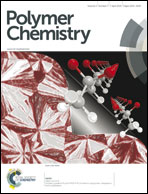A novel poly(2,6-dimethyl-1,4-phenylene oxide) with pendant imidazolium groups for high-temperature proton exchange membrane
Abstract
We designed and synthesized a novel poly(2,6-dimethyl-1,4-phenylene oxide) (PPO) with imidazolium-functionalized aromatic side chains by the reaction of imidazole-functionalized PPO and methyl iodide, and then prepared the acid doped PPO membrane by immersing the polymer membrane in phosphoric acid (PA). To achieve a high acid doping level and a high dimensional stability, the cross-linked membranes were prepared by the reaction of the imidazole groups of the polymer and 1,4-bis(bromomethyl) benzene. The PA content, area swelling, and tensile strength of the non-crosslinked and the crosslinked membranes doped with a H3PO4 solution were measured. The results showed that the crosslinked membrane with a PA content of 438% possessed the highest conductivity of 54 mS cm−1 at 140 °C with high dimensional stability and high tensile strength. Moreover, no shape change of the membranes was observed in 15 days in a Fenton solution containing 3% H2O2 and 4 ppm Fe2+ at 80 °C, indicating a high oxidative stability. Therefore, this new polymer can be considered as a promising candidate for preparing a high temperature proton exchange membrane for use in fuel cells.


 Please wait while we load your content...
Please wait while we load your content...